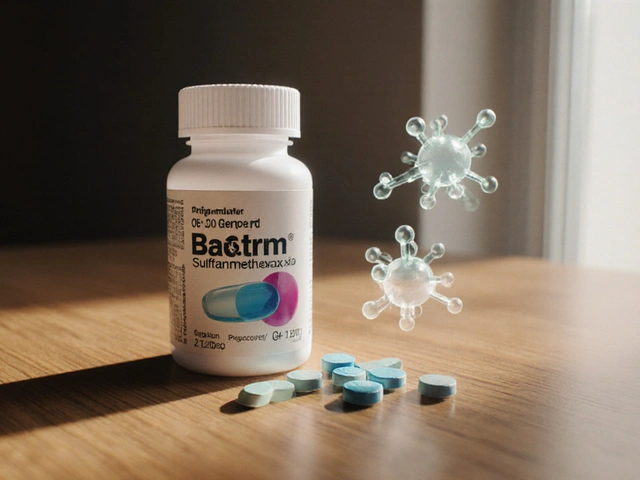Parkinson's Medication Comparison Tool
Select Conditions and Preferences
TL;DR
- Requip (ropinirole) is a dopamine agonist for Parkinson's disease and restless legs syndrome.
- Pramipexole and rotigotine are the closest rivals, offering similar efficacy with different dosing routes.
- Carbidopa/levodopa works via a different mechanism and is usually reserved for later‑stage Parkinson's.
- Side‑effect profiles differ: Requip can cause sleep attacks, pramipexole may trigger impulse control issues, rotigotine can irritate skin.
- Cost in the UK varies - generic ropinirole is cheapest, while patches (rotigotine) and brand‑name pramipexole are pricier.
When doctors prescribe Requip (Ropinirole), they’re giving a dopamine agonist that mimics dopamine in the brain. It’s approved for two main conditions: Parkinson's disease and Restless Legs Syndrome (RLS). The drug’s oral tablets are taken 2‑3 times a day, and the dose is gradually increased to minimise side effects.
How Requip Works
Ropinirole binds to dopamine D2 and D3 receptors, stimulating them just like the brain’s own dopamine would. By doing that, it helps smooth out the motor symptoms that arise when dopamine‑producing cells die off - tremor, stiffness, and slowed movement. In RLS, the same receptor activity seems to calm the uncomfortable leg sensations that force people to move their limbs at night.
What to Compare When Picking an Alternative
Before you jump to a different pill, consider five practical dimensions:
- Mechanism of action - dopamine agonist vs. levodopa precursor.
- Dosing convenience - once‑daily patch, twice‑daily tablet, or titration schedule.
- Side‑effect profile - sleepiness, impulse‑control disorders, skin irritation, etc.
- Clinical efficacy - how well it controls motor symptoms and RLS.
- Cost & insurance coverage - generic vs. brand, NHS special authority.

Side‑by‑Side Comparison
| Medication | Class | Typical Dose (UK) | Main Benefits | Common Side Effects | Approx. Monthly Cost (£) |
|---|---|---|---|---|---|
| Requip (Ropinirole) | dopamine agonist | 0.25‑5mg 2‑3×/day | Good for early‑stage PD and RLS; oral tablet | Sleepiness, nausea, sudden sleep attacks | £12‑£25 (generic) |
| Pramipexole (Mirapex) | dopamine agonist | 0.125‑4.5mg 1‑2×/day | High receptor affinity; once‑daily possible | Impulse control issues, edema, hallucinations | £30‑£55 (brand) |
| Rotigotine (Neupro) | dopamine agonist (patch) | 2‑8mg/24h patch | Steady drug level; ideal for nighttime RLS | Skin irritation, dizziness, insomnia | £70‑£95 (patch) |
| Bromocriptine | ergot dopamine agonist | 1.25‑10mg 3×/day | Long‑standing drug; cheap generic | Fibrosis, nausea, orthostatic hypotension | £8‑£15 |
| Carbidopa/Levodopa (Sinemet) | dopamine precursor | 25/100mg 3‑4×/day | Most potent for motor control; works late‑stage | Motor fluctuations, dyskinesia, nausea | £20‑£40 (generic) |
Deep Dive Into Each Alternative
Pramipexole
Pramipexole, sold as Mirapex, is another dopamine agonist but with a higher binding affinity for D3 receptors. That makes it very effective for both Parkinson’s motor symptoms and RLS. The biggest upside is that many patients can stay on a once‑daily dose after titration, meaning fewer pills to remember. However, you’ll hear a lot about impulse‑control problems - gambling, compulsive shopping, even hypersexuality. If you have a history of such behaviours, discuss alternatives with your neurologist.
Rotigotine
Rotigotine comes as a skin‑applied patch that releases the drug continuously over 24hours. It eliminates the peaks and troughs you get from tablets, so some people experience smoother symptom control, especially overnight. The trade‑off is skin irritation at the application site and a higher price tag. You’ll need to rotate patch locations weekly to avoid dermatitis.
Bromocriptine
Older than the other agents, bromocriptine is an ergot‑derived dopamine agonist. It’s cheap and still prescribed in some NHS formularies, but the ergot backbone can cause fibrosis of heart valves or lungs in rare cases. Because of that risk, many clinicians reserve it for patients who cannot tolerate newer non‑ergot drugs.
Carbidopa/Levodopa
Unlike the previous drugs, carbidopa/levodopa isn’t a dopamine agonist; it supplies the brain with the actual building block of dopamine. It’s the most effective medication for advanced Parkinson’s, but long‑term use often leads to motor fluctuations (wear‑off) and dyskinesias. Most doctors start patients on a dopamine agonist like Requip to delay levodopa exposure. When symptoms become too severe, levodopa is added or switched to.
Choosing the Right Option for You
Think of the choice like picking a car. Requip is the reliable hatchback - cheap, easy to drive, and gets you where you need to go. Pramipexole feels like a sporty sedan - a bit pricier but offers smoother handling. Rotigotine is the electric vehicle of the lot - quiet and consistent, yet you pay more for the battery (patch). Bromocriptine is the older diesel: cheap, but you worry about emissions (fibrosis). Carbidopa/levodopa? That’s the high‑performance sports car - powerful but demanding on maintenance (side‑effects).
Ask yourself these three questions:
- Am I early in my Parkinson’s journey or dealing primarily with RLS?
- Do I prefer pills or would a patch fit my routine better?
- How sensitive am I to side‑effects like sleepiness or impulse‑control issues?
Answering honestly will point you toward the medication that balances efficacy, safety, and cost for your lifestyle.
Practical Tips & Common Pitfalls
- Start low, go slow. All dopamine agonists need gradual titration to avoid nausea and dizziness.
- Watch for sudden sleep. Even if you feel fine, schedule a trial drive before operating machinery.
- Check blood pressure. Some agents can cause orthostatic drops - rise slowly from sitting.
- Review skin with rotigotine. Rotate patch sites and keep the area clean.
- Discuss insurance. NHS special authority may be required for brand‑name pramipexole; generic ropinirole is usually straightforward.

Frequently Asked Questions
What makes Requip different from other dopamine agonists?
Requip (ropinirole) has a shorter half‑life than pramipexole, meaning it clears the system faster. This can be an advantage if you experience side effects, but it also requires more frequent dosing.
Can I switch from Requip to a patch like Rotigotine?
Yes, many neurologists perform a cross‑taper: slowly reduce ropinirole while starting the rotigotine patch at a low dose. Close monitoring for worsening symptoms or skin irritation is essential.
Is it safe to combine Requip with levodopa?
Combining a dopamine agonist with levodopa is common practice and can smooth out motor fluctuations. Your doctor will adjust both doses to minimize dyskinesia.
Why do some patients experience impulse‑control disorders on pramipexole?
Pramipexole’s strong affinity for D3 receptors, which are abundant in brain regions governing reward, can heighten compulsive behaviours in susceptible individuals.
How do I know if my side effects are from the drug or from Parkinson’s itself?
Track when symptoms start relative to dose changes. Sudden sleepiness right after a dose increase likely points to the medication, while tremor that progresses despite stable dosing may be disease‑related.





Calandra Harris
September 30, 2025 AT 19:00Requip is just another pharma cash cow.
Dan Burbank
October 3, 2025 AT 10:53Behold the saga of dopamine agonists! The lofty promises of Requip mask a labyrinth of side effects that haunt the unwary. One cannot ignore the silent specter of sleep attacks that lurk behind the next dose. Yet, the market applauds its modest price as if it were a virtue. In the grand theater of Parkinson's treatment, the curtain never truly falls.
Anna Marie
October 6, 2025 AT 02:47While the article offers a thorough comparison, it is essential to acknowledge the patient’s lived experience. The nuanced balance between efficacy and tolerability often dictates adherence more than any cost analysis. Clinicians should therefore tailor therapy to individual rhythms, not merely to guideline tables.
Abdulraheem yahya
October 8, 2025 AT 18:40Choosing a medication for Parkinson’s or restless legs is akin to navigating a crowded marketplace, each stall promising relief while hiding hidden charges. Requip, with its short half‑life, offers a flexibility that can be both a blessing and a curse, demanding multiple daily doses that challenge even the most disciplined patient. The frequent dosing can inadvertently reinforce the disease’s rhythm, reminding patients of their condition throughout the day. In contrast, the rotigotine patch glides silently across the skin, delivering a steady stream of dopamine agonist that steadies motor fluctuations without the peaks that cause jittery wakefulness. Yet this innovation comes at the price of dermatological irritation, a minor scar for many but a barrier for those with sensitive epidermis. Pramipexole, praised for its high receptor affinity, carries the shadow of impulse control disorders, a psychological side effect that can erode personal relationships and financial stability. Bromocriptine, the elder statesman of the class, whispers of affordability but shouts of rare yet severe fibrosis that demands vigilant cardiac monitoring. Carbidopa/levodopa remains the powerhouse, reserved for later stages, but its long‑term use breeds dyskinesias that can be as disabling as the disease itself. Each option demands a conversation between neurologist and patient, an ethical pact that respects autonomy while guiding toward the most sustainable outcome. Economically, generic ropinirole stands as the most modest contender, fitting within the tight budgets of many health systems, yet its cost advantage may be offset by the need for additional supportive therapies to manage sleepiness. The patch, though costly, reduces pill burden and may improve nighttime quality of life for restless‑leg sufferers who struggle with insomnia. Insurance formularies, especially within the NHS, often impose special authority for brand‑name options, nudging prescribers toward generics unless clinical nuance dictates otherwise. Moreover, the socio‑cultural context influences adherence; patients in certain regions may prefer oral tablets due to stigma surrounding topical treatments. Ultimately, the decision matrix resembles a complex equation where efficacy, side‑effect profile, cost, and personal preference intersect. By weighing these variables thoughtfully, patients can steer toward a regimen that supports their functional independence rather than merely suppressing symptoms.
Preeti Sharma
October 11, 2025 AT 10:33One might argue that the emphasis on cost eclipses the importance of patient‑centered outcomes, yet the article subtly reminds us that affordability is not merely a fiscal concern but a determinant of long‑term adherence.
Claire Kondash
October 14, 2025 AT 02:27The dopamine agonist landscape evokes a tapestry of choices, each thread woven with clinical evidence and lived narratives 🌐. While Requip offers a pragmatic entry point, the philosophical question remains: does the pursuit of symptomatic relief diminish the quest for holistic well‑being? 🤔
Matt Tait
October 16, 2025 AT 18:20Honestly this guide glosses over the real danger of sleep attacks on Requip and pretends it’s a minor inconvenience. Patients deserve a blunt warning, not a sugar‑coated disclaimer.
neethu Sreenivas
October 19, 2025 AT 10:13I appreciate the thorough breakdown; it aligns with what many of us experience daily 😊. The side‑effect tables are especially useful for planning medication schedules.
Brenda Martinez
October 22, 2025 AT 02:07Behold the tragic drama of a drug that promises freedom yet drags its users into nocturnal abyss. The narrative of Requip is a cautionary tale of hope betrayed by relentless drowsiness, a vortex that devours ambition and joy.
Marlene Schanz
October 24, 2025 AT 18:00i think the article does a good job but maybe could use more real life story from ppl on the ground. cost is big dev but generics help.
Matthew Ulvik
October 27, 2025 AT 08:53Great post! I’ve been on Requip for a while and the sleepiness hit me hard, but the doc helped adjust the dose. 👍
Dharmendra Singh
October 30, 2025 AT 00:47The piece captures the essence of balancing efficay and cost. In many Indian families, the decision also hinges on who can afford the monthly script, making the generic choice critical.
Rocco Abel
November 1, 2025 AT 16:40Behind the polished tables lies a pharma agenda pushing dopamine agonists to lock patients into lifelong dependency, a silent orchestration masked as clinical advancement.
Dawn Mich
November 4, 2025 AT 08:33Don’t be fooled by the mainstream narrative; the hidden hand of big pharma manipulates research to hide the severe cardiac risks associated with ergot derivatives like bromocriptine.
Eric Sevigny
November 7, 2025 AT 00:27For those considering a switch, a gradual cross‑taper from ropinirole to rotigotine typically starts with a low‑dose patch while halving the oral dose, monitoring for skin irritation.
Glenda Rosa
November 9, 2025 AT 16:20While the article’s calm tone paints Requip as the sensible workhorse, let’s not ignore that its fleeting half‑life is a flashy trick that lures patients into a perpetual dosing carousel.
charlise webster
November 12, 2025 AT 08:13Conversely, the consistency of a short‑acting agent can be a virtue, allowing rapid titration and minimizing long‑term exposure to dopaminergic excess.